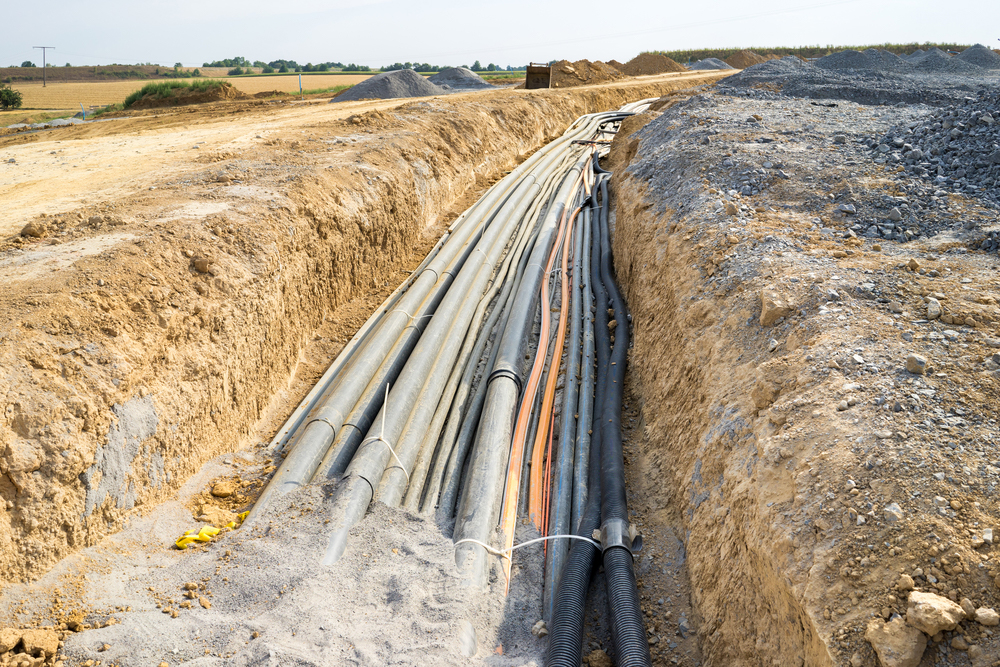In the days of Netflix, amazon Video and other video-on-demand streaming services, a slow Internet connection is frustrating for private users. For companies, a slow or unreliable Internet connection can result in a significant competitive disadvantage in increasingly globalised markets. Viewed at an economic level, the loss of productivity and the competitive disadvantages resulting from a lack of data infrastructure are enormously damaging for the country and society.
FTTH: High-speed fibre-optic Internet into your home
The need for high-speed Internet and data connections is indisputable and has been increasing continuously for years. Therefore, the building of a high-performance network infrastructure is essential. The best suited technology with regard to performance, sustainability and future reliability is data transmission via fibre-optics. Here the physical limits are currently far in the distant future, due to the nature of the medium. Today, major Internet connections with huge bandwidths are already being realised using high-speed fibre-optics.
To be able to supply individual companies and even private households with the demanded high bandwidths in future, it is necessary to extend the fibre-optic network nationwide. The laying of fibre-optic cables to the end customer’s building is known as Fibre To The Home (FTTH). With this network concept, the supply of each individual customer with the highest bandwidths can be ensured today – and, above all, in the long-term future.

The challenges involved in building the network are currently related to funding the very high cost for the physical construction of the FTTH fibre-optic networks, and in the realisation of economic business models for the use and marketing of the new data networks themselves, which ought to refinance the investments.
The following three paragraphs are reflecting the situation in Germany.
In Germany, the rollout of FTTH is making slow progress: compared with other OECD countries, Germany is far down the list at 28th of 32 in Europe. Reasons for this include, for example, conservative politics which set unambitious targets for building the national broadband network. But a lack of competition and the protectionist behaviour of the former monopoly holder, Deutsche Telekom, are also holding back the introduction of FTTH. By using short-term bridging technologies based on the existing but technically-outdated copper twisted pair cables, such as VDSL and vectoring, they are limiting the construction of modern, fibre-optics-based FTTH networks.
Only in the last two years have there been signs of a change. The federal government has facilitated appropriate funding programmes for rolling out broadband, as well as a variant of the funding via subsidised loans. The use of funding also helps small municipalities and rural communities to get into FTTH construction. At the same time, the funding requires adherence to appropriate conditions, for example, the Open Access regulation. This requires open and discrimination-free access to the infrastructure set up using the funding. This puts particular demands on the network technology.
In general, because of the decentralisation of the networks due to FTTH construction, there will be a shift towards small network operators, similar to how it has been for the energy transition. This primarily offers municipal utility companies, local energy network operators and communities access to operator models and the opportunity for the sustainable supply and management of local FTTH fibre-optic networks.
HCD Consulting supports you
Thanks to its access to a wide-ranging network of experts, HCD Consulting is able to offer comprehensive consulting services for specific FTTH-construction topics, in order to meet the diverse conceptual and organisational challenges in planning, implementing and operating FTTH networks. We are happy to support you: from advice on the use of funding, finding suitable service providers for planning and building the physical network, through to the selection of the operator model, the creation of a network design and establishing Open Access capability for your FTTH network. If you are looking for suitable partners for implementation and advance procurement, we will put you in touch with an appropriate selection of service providers and suppliers.
In the active network technology sector, we are able to draw on expertise from our long-term supplier relationships with municipal electricity operators, public utility companies and also large network operators. We will supply you with appropriate hardware to build your access network. We recommend using the DZS MileGate series, which is characterised by its very high port density and low current consumption per port. The powerful and future-proof MX series routers from Juniper Networks are particularly suitable for a high-performance and future-proof IP backbone network, which serves as the central element for data transport within your FTTH network. Use of EX and QFX series Juniper Networks switches in the data centre zone will supplement your network topology to give a cohesive overall appearance.
Regarding Green IT, we are committed to considering energy efficiency criteria when selecting network components and offering you an optimum product mix of new and refurbished equipment – to reduce costs, boost your corporate image and help protect the environment. Profit from our years of market experience and get professional advice about Green IT solutions in FTTH.

Questions?
Just ask!
I am Alexander Zagler from the HCD sales team. I will be happy to advise you or assist you with any questions. You can phone me on +49 89 215 36 92-0 or reach me using our contact form.
Contact us
 Deutsch
Deutsch